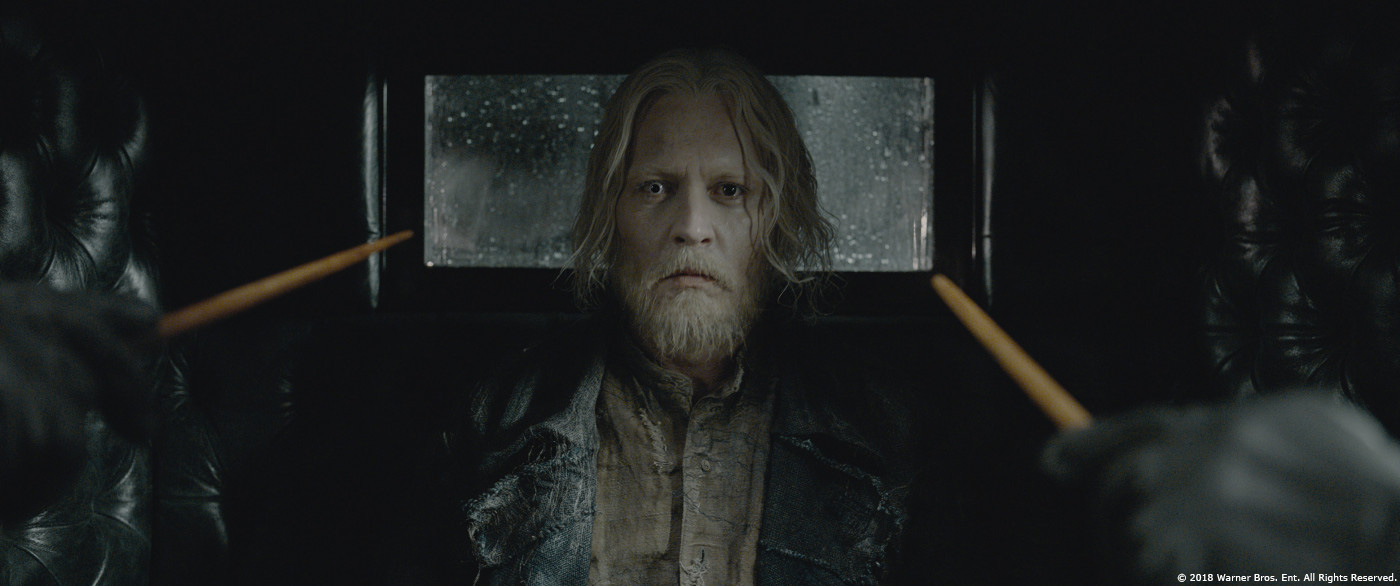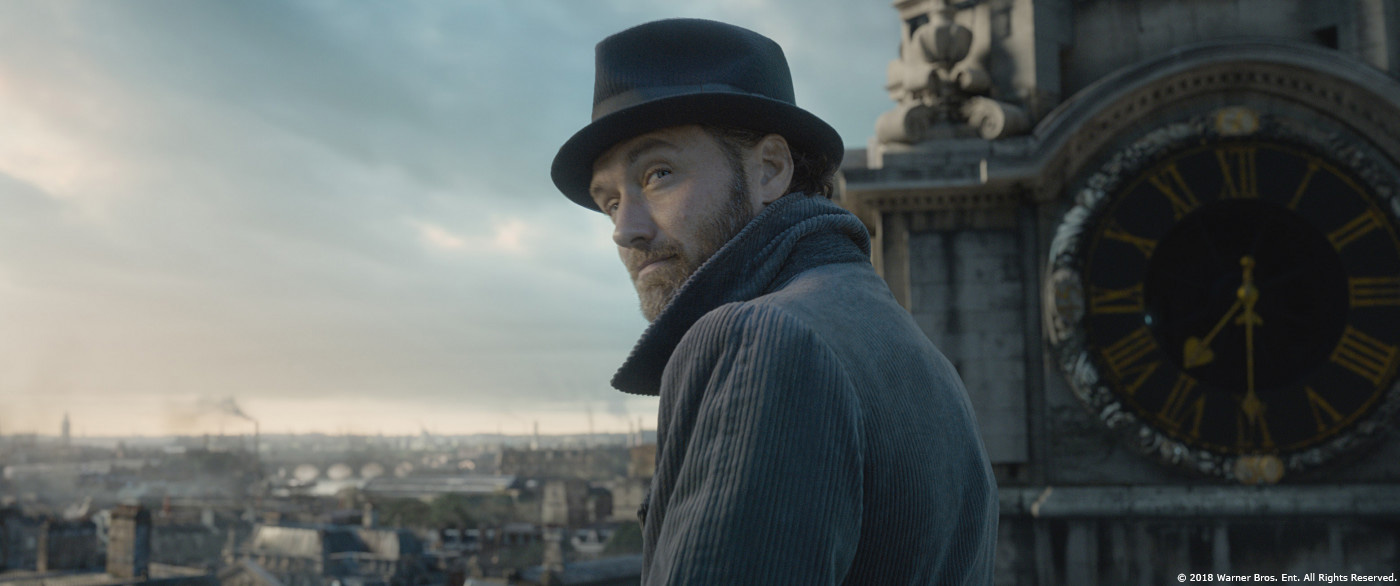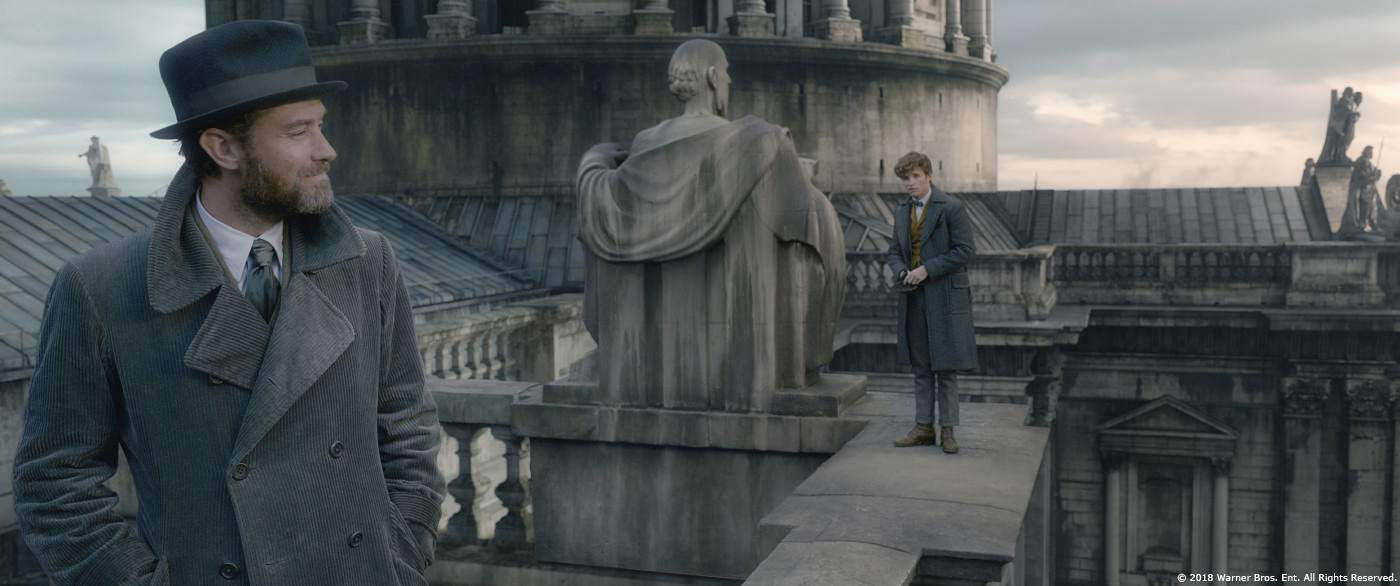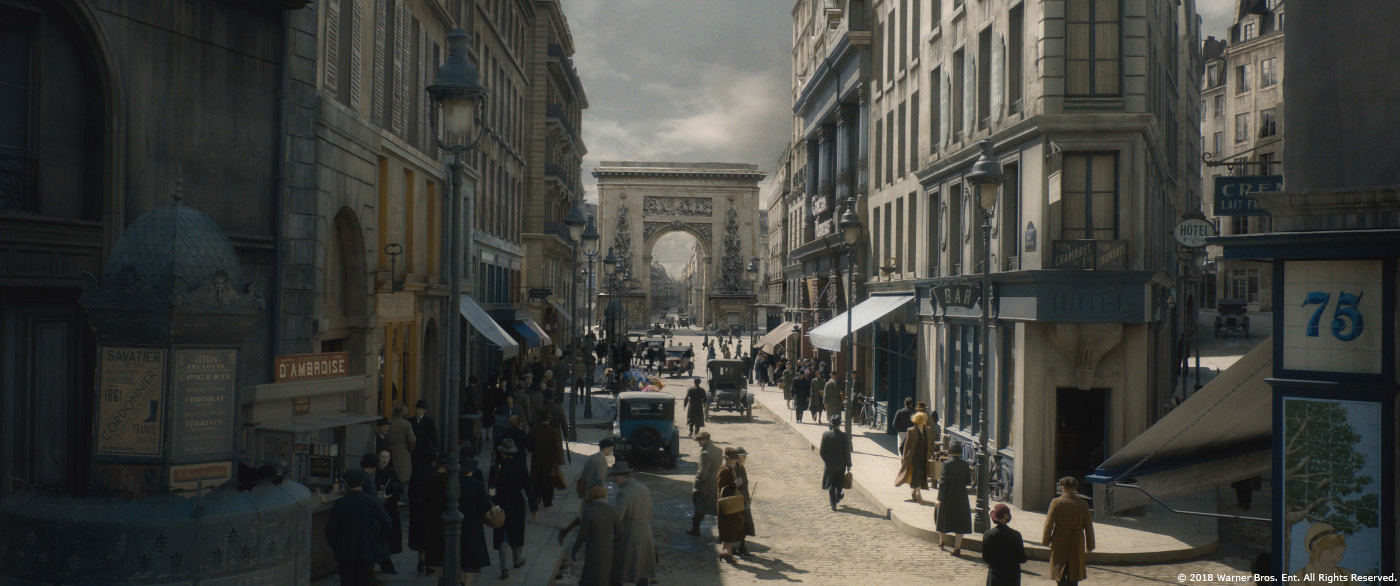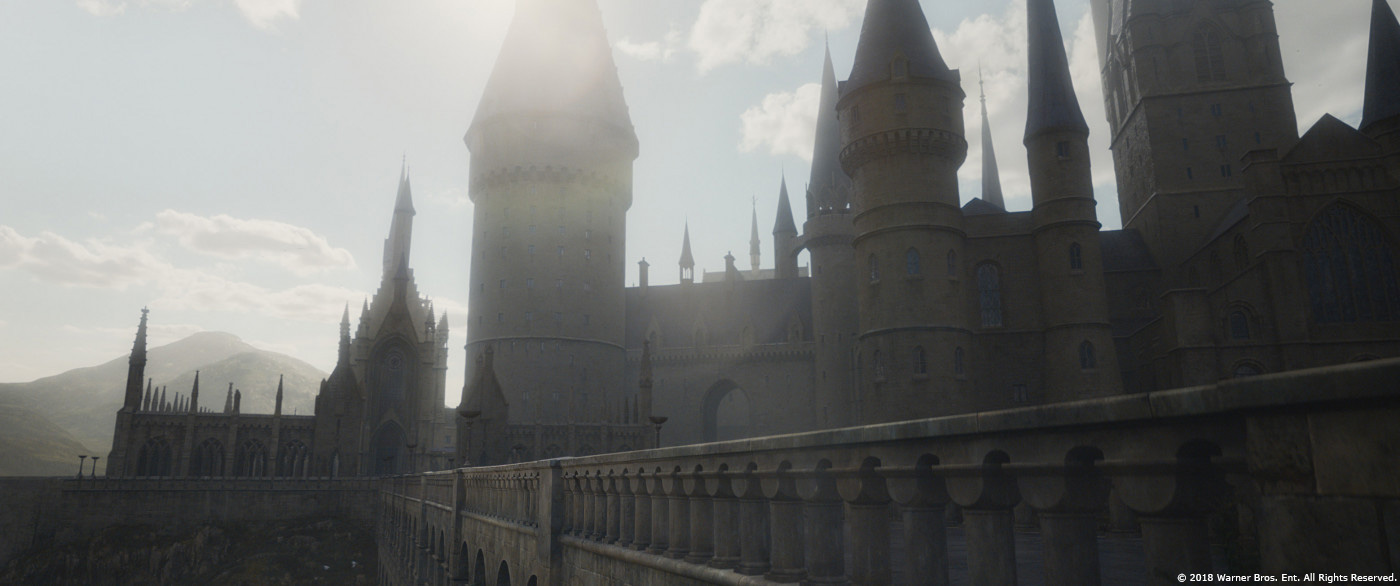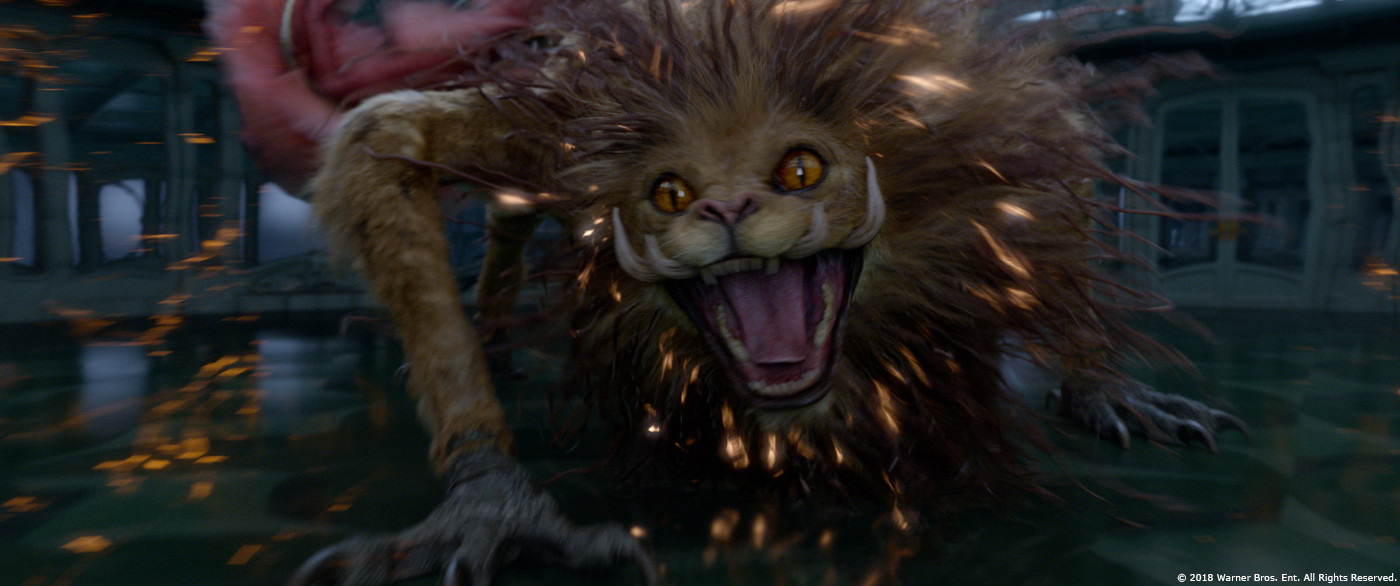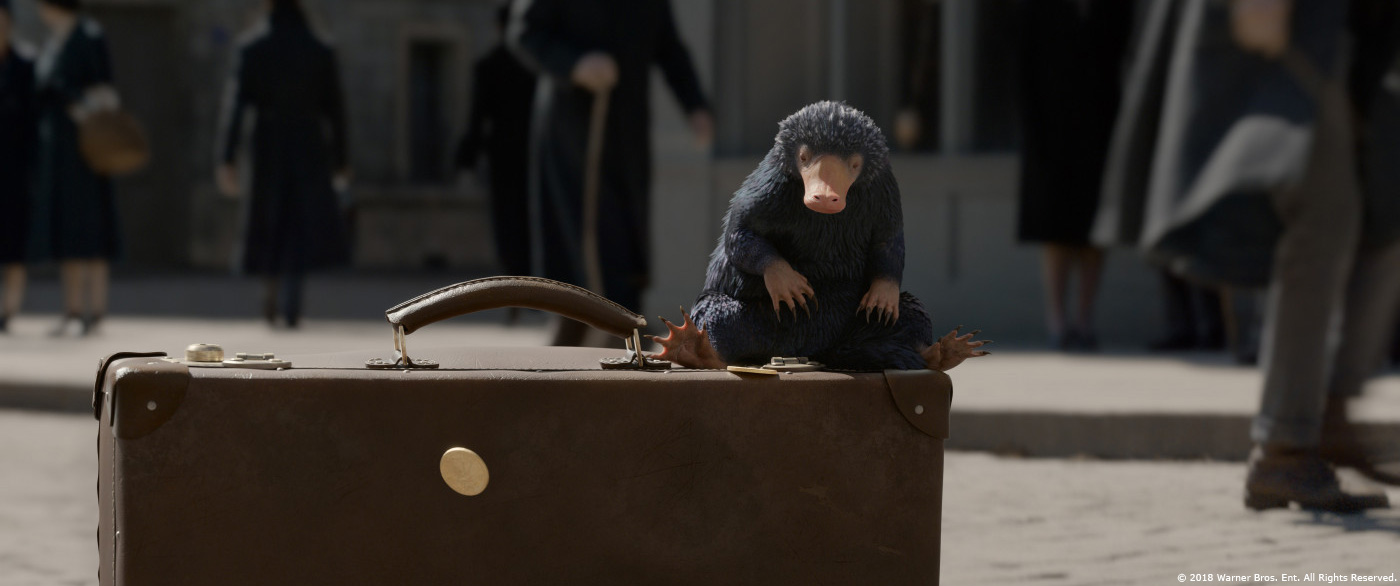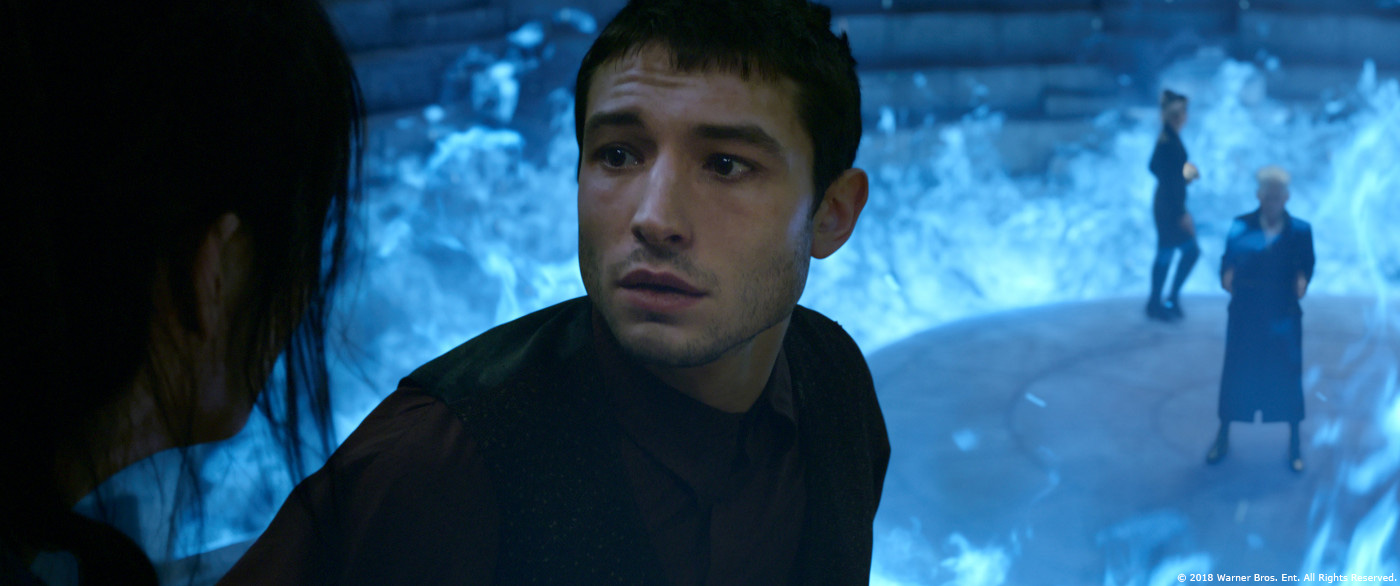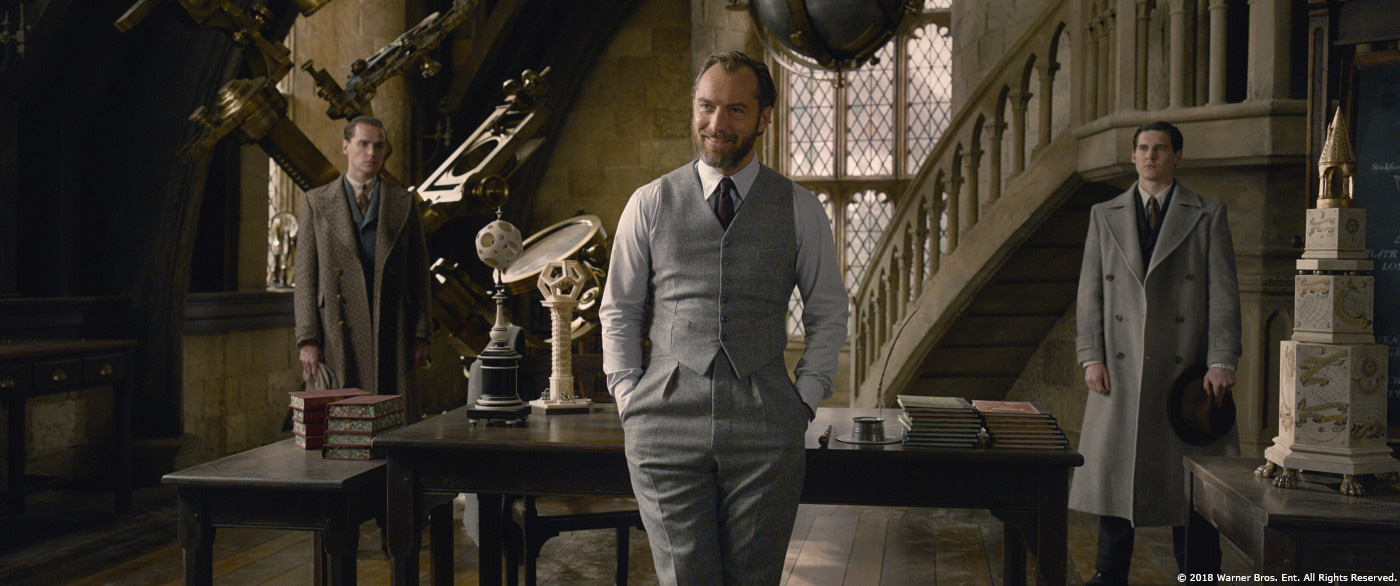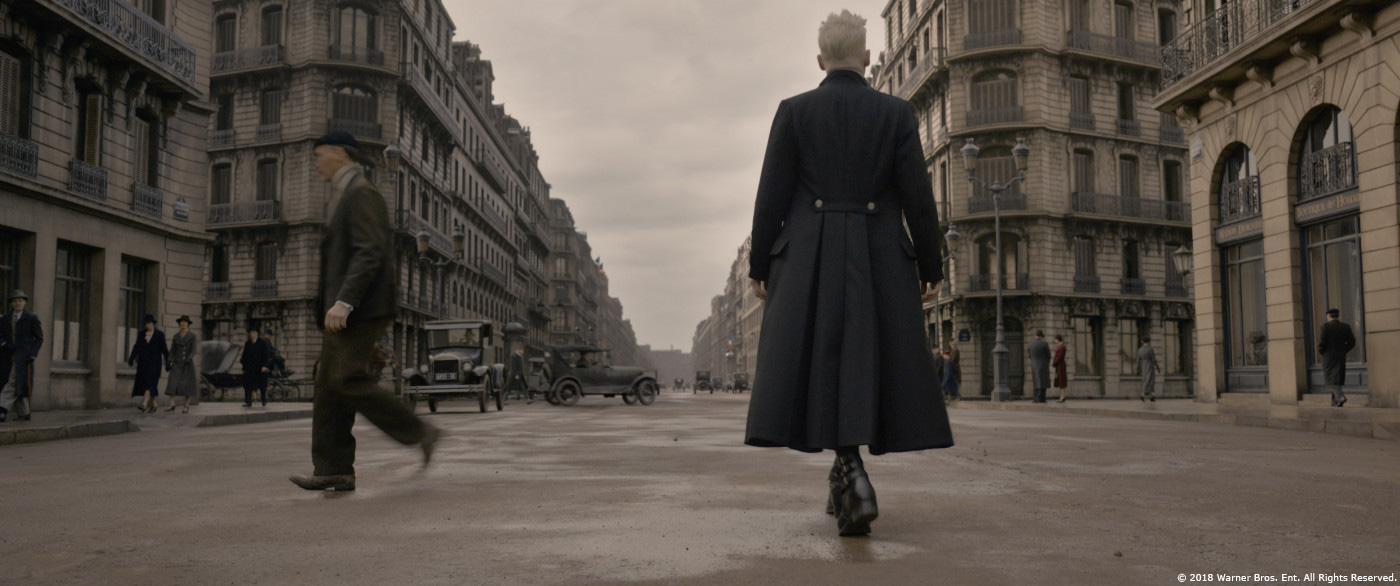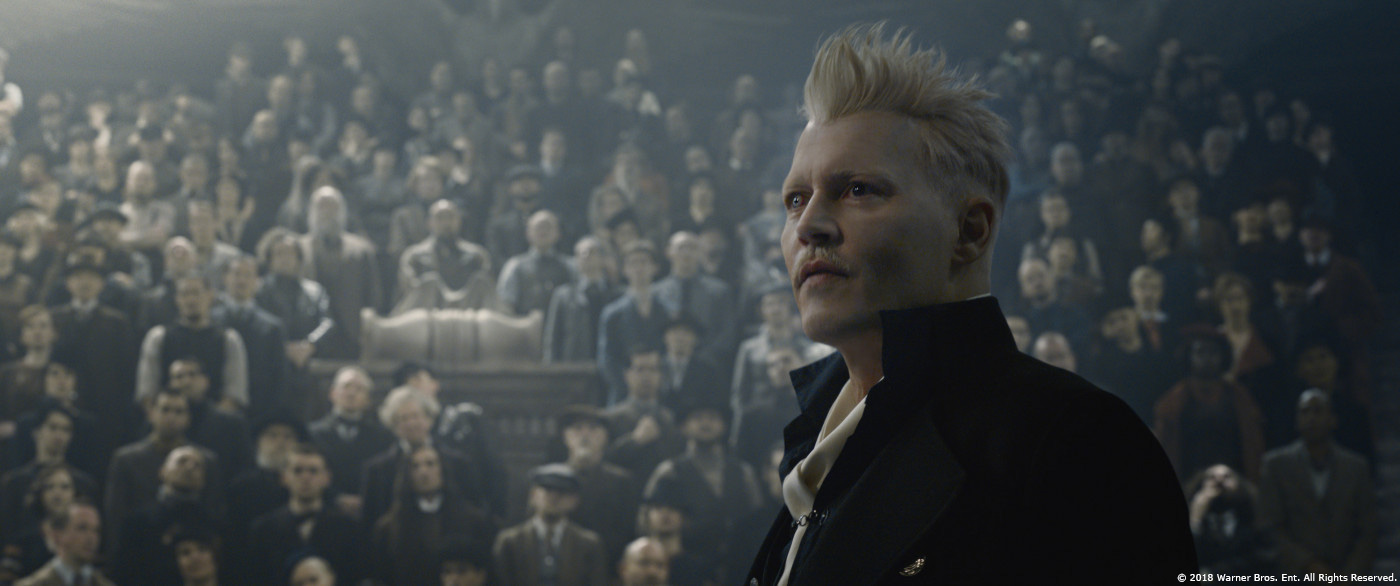In 2016, Tim Burke and Christian Manz told us in detail about their work on FANTASTIC BEASTS AND WHERE TO FIND THEM. They are now back to tell us more about THE CRIMES OF GRINDELWALD.
How was this new collaboration with director David Yates?
Tim Burke // As always collaborating with David was great, this was the seventh film I have done with him over the last 13 years, so we have a very good working relationship. At the beginning of pre-production David challenged both Christian and I to really try and push the creativity and originality for the VFX for this film to a new level, he wanted us to think outside the box and really have fun with the creatures and sequences. We both embraced this challenge and hopefully the results speak for themselves.
Christian Manz // Working with David for the second time was great as Tim says. He strives to get the best out of us but also gives us a lot of space to propose ideas and collaborate with the other departments on the film.
What are the main changes on the VFX side since the first Fantastic Beasts movie?
Tim Burke // There were no major changes on how we worked on this movie, the crew were not all the same but our approach to design, previs, postvis and finally completing the movie was very similar, but more streamlined and efficient.
How did you organize the work between you two and with your VFX Producer?
Tim Burke // Christian and I worked on the whole film together in pre-production for the first few months, then as the script settled down and the work became clearer, we started to divide the creatures and sequences between us, to create an even distribution of workload. We each wanted to handle a few large action sequences and we didn’t want to divide creatures across facilities, so we kept environments with creatures as much as possible and minimised the shot sharing. We both work with very experience senior coordinators, so the day to day running of the work and communication about creative and the technical is handled by ourselves. Olly Young and Nicky Coats who co-produced the film, looked after the film as whole, dealing with the facility producers directly.
Can you tell us more about the previz and postviz work?
Tim Burke // We brought in a previs team from The Third Floor led by Vincent Aupetit and Stewart Ash. However we also created our own in-house creature development team led by Nathan McConnel, animation supervisor from Framestore. Nathans team of crack animators helped design the creatures through extensive movement and character studies. They also then went on to help design and previs key sequences featuring some of the Beasts, such as those involving the Zouwu, the nifflers, baby nifflers, Pickett, the Circus creatures, Nagini etc. The Third Floor team handled a lot of the action sequences such as the third act in the cemetery. We worked alongside Davids storyboard artist, but predominantly designed the sequences ourselves, sometimes storyboarding ideas to show David for his approval and feedback before getting into shot production. All of the action sequences in the film were prevised, and each one evolved and developed into something much bigger than how it had been originally conceived in the script.
Once we moved into post-vis Stewart Ash stayed on with a smaller TTF team to look after some of the sequences they had previously prevised, whilst a team from Nvizage led by Sam Churchill came onboard to work with me, along with another team from Proof led by Jon Allen, who worked solely with Christian.
As with the first film we took the rough cuts from the editor Mark Day, and blocked in creatures and environments pretty quickly for over 2000 shots in an assembled film that was roughly around three hours long. This allowed David and Mark to edit freely and give us instant feedback on what they required. The constant back and forth between editorial and ourselves allowed the film and story to develop, showing David where there were issues to resolve or where sequences needed to be further expanded. This process took us to the first showing of the directors cut to the studio, we then started to refine the assets and work further into sequences with a view to creating a better version of the film in post vis for the first audience recruit. We continued in this way, further refining sequences and posvising the additional photography for subsequent audience recruits, whilst in the meantime after the directors cut, we turned over all of the sequences to the individual facilities who were going to execute the final work, so they could get started on shot production.
Stephen Clee and Blair McNaughton from Method Studios came over to work in our animation team at leavesden to look after the creatures in Newts London basement, such as the baby nifflers, leucrocotta, panda pig, mooncalves, augery and the kelpie. As Method had been awarded these sequences I really wanted their animation supervisor and lead to be involved early in the process, and having both Stephen and Blair working with us at Leavesden was a great asset. Likewise Nathan was able to postvis the animation for the Framestore creatures, such as the Zouwu, which was really great as his team had been instrumental in developing the characters of these creatures in previs.
The post vis process worked extremely smoothly because the key team members were involved from very early on in the the design of the original sequences in previs.
After New York, we discover London and Paris in this new episode. How did you approach their recreation?
Tim Burke // Similarly to the New York build on BEASTS one, we carried out an extensive photographic and LIDAR survey of key environments and buildings in all of our locations. This work was executed by Clear Angle Studios who spent weeks surveying and photographing Paris and London, as well as other locations such as Laycock. All of this material was used for layouts in postvis then handed over to the facilities for the higher res builds.
Christian Manz // We approached the sets and environments in a similar way to what we did on the first film. The key thing was our collaboration with Production Designer Stuart Craig and the art department so that our work could be blended seamlessly with the practical sets to his direction.
What indications and references did you received for London and Paris?
Christian Manz // Stuart started with concept images of each environment created by various artists. We also went on various location scouts in Paris and London to find buildings and areas that both David and Stuart liked for each scene in the film. Photographs from these scouts were used by the VFX Art Director, Hayley Easton Street, to create artwork for each location that included real buildings extending the back lot and stage sets. We were also supplied with period photographs to use as reference not only for the architecture but also the dressing – guided by Set Decorator Anna Pinnock.
Can you explain in detail about the creation of these cities?
Christian Manz // Hayley’s artwork gave us a shopping list of architecture which Clear Angle Studios LIDAR scanned and texture photographed over a month long period in Paris and London. Unlike New York we were able to scan whole streets as a lot of the period buildings are intact. We were able to use all of this data in postvis to do layouts for all of the scenes to a fairly high level – our environment artist Scott McInnes worked with the in-house team on hundreds of shots. We were able to show these to Stuart Craig to get his blessing – it was great to have his input at the early post production stage and get some of the key creative signed off.
All of our capture data, reference and the post vis layouts were then handed over to the studios handling the final asset builds and shots. Paris and London were worked on at Framestore in London and Montreal, Rodeo FX, Image Engine and DNEG.
For the key establishing shots created by Framestore and Image Engine, the facilities shared asset builds and based their layout and cameras on plate photography reference. For one shot Framestore were able to apply a camera move to a 2.5 re-projection of a locked of 2nd Unit plate filmed from Notre Dame which then had extensive paint fixes and CG augmentation.
The main difference from the first film is that we always started with something ‘real’ either as reference or plate to push our selves to make the end result as photographic as possible. Some (hopefully) invisible work we did wad in the scene where Jacob and Queenie argue in a London street outside Newt’s house. The scene was shot at night on location with no VFX required. However script changes meant we ended up reshooting the scene against green screen at night on the Leavesden backlot. Image Engine used the LIDAR, texture data and plate photography from the original shoot to create a digital version of the street – what is seen in all of the shots in the finished film is their CG set.
How did you handle the lighting challenge?
Christian Manz // The hard and fast rule we set from the start was that if the scene was exterior daylight, we would shoot it outside. The art department there built quite a few small sets representing roof tops and the like alongside the larger Paris streets on the backlot. Though more challenging shoot wise we felt it would give us the best chance of seamlessly blending our plates and physically based lit CG extensions in the final shots.
For the London Fog sequence we took the decision to shoot partial sets on blacked out stages – the practical lighting diffused through the SFX mist became a cue for our extensions where the shapes the light made between the characters and buildings was more important to create the mood, atmosphere and depth than subtle architectural detail – DoP Philippe Rousselot gave a some amazing period reference photographs which we gave to Framestore to help them develop the look of the final shots.
Where did you filmed the various locations?
Tim Burke // Second unit filmed various plates for us along with the help of VFX supervisor Rob Duncan, in Scotland, Paris and London. Main unit shot mostly on the backlot sets and interior stages at Leavesden, but we did spend a few days filming in Laycock, which was for some of the flash back scenes in Hogwarts, a location used previously on Harry Potter films.
We are also back to Hogwarts. What was your feeling to recreate this iconic place?
Tim Burke // It was very strange revisiting Hogwarts, when we finished DEATHLY HALLOWS PART 2 it really felt like the end, the final images from that film showed it destroyed and in ruins! Back then I couldn’t imagine that I would ever work on a film which would require it to be rebuilt. DNEG who built the digital asset of the school for DEATHLY HALLOWS PART 2 were obviously asked to do all of the exterior work on this film.
Can you explain in detail about the creation of the school and its huge environment?
Tim Burke // The asset of the school and surrounding environment was brought back from archive and a lot of the textures were updated and improved. All of the build work had happened back in 2010 for THE DEATHLY HALLOWS. One thing that soon became apparent was that we had never actually showed the completed digital school in DEATHLY HALLOWS, as it was always under attack during the final battle and ended up being partly destroyed. So when we started to render it full screen in day light conditions, we realised that some of the details from the original build were incorrect or simply not good enough and we had to go back and make quite a few corrections and improvements. A lot of the landscapes were also retextured to work for the specific shots in the film, for the time of day, different skies etc.
Christian Manz // One interesting challenge was the single shot of The Great Hall. As David only wanted this one moment there was never any plan to rebuild this huge set. However we were very lucky in having the original set standing as part of the Warner Bros Harry Potter Tour next door to the studio. Clear Angle Studios went in overnight to LIDAR scan and texture photograph the the set for us. We used this to create a Postvis version of the shot with Proof referencing various Potter films for the layout of the candles, tables and crockery. When Framestore in Montreal moved onto the final asset build we realised that the floor in the tour version of the Great Hall didn’t match what we saw in the films so we tweaked it’s layout and colour. For lighting we matched the look of the material we shot on location at Lacock to make it feel part of the same environment.
Let’s talk about the creatures and especially the new big one, Zouwu. How did you design and create it?
Tim Burke // As with the first film the design process was kept very fluid and loose. A team of concept artists sketched ideas which we presented to David, ones that he liked were then quickly modelled and given basic animation rigs and Nathan and the team got to work looking at movement studies. Again these were presented to David and his feedback was then actioned, either to lose the beasts and start again or push forward with the design. Often the beast would go back into 2D concept to experiment with the look of the creature, colour palette and more close up detailed of aspects of the face. The Zouwu went through this very process and interestingly took many different directions along the way.
Initially the design represented a very large lion/puma type big cat, and David liked it but felt it was a little safe and conventional. He again challenged us to try and created something more unusual so we pushed the designs into something a lot more weird and wacky, part bird, part big cat, part lizard. David liked the 2D concept but struggled to see how this creature would behave and what it’s character would be. We had referenced a lot of Chinese influences, the creature being from Chinese mythology, and in particular wanted to give it characteristics not dissimilar to a Chinese dragon. Mike Brunet started experimenting in animation as to how the creature would move, and came up with some crazy studies of a part lizard, part dragon type eccentric character that David loved, and we knew we had our Zouwu. However it was hard to nail the final design in 2D so we progressed with the asset build at Framestore, led by Andy Kind, and through a series of studies and turntables came up withe the final groom for the fur and mane, colour and design of the tiger stripes on the body and look and material of the tail.
What was the main challenge with Zouwu?
Tim Burke // There were many challenges, often because of the need to clarify the creatures story arc within the film. David was keen to have the creature exist throughout the film and not just in one scene. In the original script Newt, Tina and Leta all ride the creature out of the French Ministry, which worried me a lot as making one person ride a creature convincingly is hard, but three people sitting on a extremely articulated spine would be very difficult. There was no real description of how they escaped either, other than the Zouwu could travel great distances. We worked with David to come up with a new story arc for the creature, first meeting her at Skenders circus where she had been chained and bound so her magical powers were restricted, where she was a caged wild animal on display. From here she escapes and Newt has to track and capture her. The sequence with Newt and the toy on the bridge came out of ideas we threw around in previs, which David loved because it was so “Newt like” and bizarre. The scene when Newt removes the chains from her in the suitcase was an important bonding moment Eddie Redmayne wanted to do, to show how he could get her trust and form a bond and relationship with her. This was done as a last minute addition to the end of principle photography. The problem of having three riders was solved by Newt keeping Tina and Leta in his suitcase when he escapes from the ministry, so we only had to film Eddie riding on our mantronic green screen buck, which was puppeteered and operated by the stunt team. For half of the shots where Newt is riding the Zouwu he is a digital double and the environment is digital at all times. The idea for the escape from the ministry was inspired by the mythology of her ability to travel great distances, we thought “what if this could happen in a few seconds”, where she can meld and warp the environments around her to transition from one to the other. We did some initial sketches of what this might look like and along with Andy Kind at Framestore, designed the time warp effect where she and Newt travel from the French Ministry to the cemetery. These were massively complicated shots involving a lot of development work into how the environments would transition from solid geometry into fluids and back to solid geometry.
Many creatures are back such as Bowtruckle and Niffler. How did you enhance their model?
Tim Burke // These were as per the previous film, there were no updates necessary, however Framestore Montreal rather than Framestore London did the work on the niffler.
Christian Manz // Apart from a few rig and model refinements these were the same as in the last film. We did create a baby version of Pickett for one scene. We re-proportioned his head and body to give him a bit of a younger feel.
Which one is your favorite and which one was the most complicate to create?
Tim Burke // The Zouwu, for all of the reasons I have mentioned above.
Christian Manz // Mine is still the Niffler – it was great to think of new things for him to do. Though his appearance is brief we wanted to give the audience a bit what they enjoyed in the first film.
The final sequence has beautiful and terryfing blue dragons. Can you explain in detail about their design and their creation?
Tim Burke // David wanted a big epic sequence to complete the scene in the amphitheatre and finish the third act. I discussed a few ideas with him on how the blue fire could evolve into creatures and we sketched some rough concepts which he liked. We then designed the sequence in previs; initially once the wizards had broken out into the cemetery they were being attacked repeatedly by the blue fire creatures, but David wanted a stronger underlying theme, so I reminded him how powerful it was when Dumbledore used fire to defeat the Inferi in HP6. He agreed, he really liked the idea of using fire to fight fire, so we re-blocked the previs and came up with the idea that the wizards were having to contain and defeat the blue fire by using the positive fire spell, working together to defeat a common enemy, something that David was very keen to get across in the sequence, they wouldn’t defeat these creatures alone, they had to work as a team. It allowed us to create a really powerful sequence with a great sense of scale and drama, which Tom Proctor at DNEG supervised and helped bring all of the elements and final look together superbly.
This sequence is full of FX. How did you handle the art direction for their animation and look?
Tim Burke // We postvised the sequence with Nvizble using basic Maya simulations for the fire, we kept it very low res and concentrated more on the choreography and blocking of the two types of fire. DNEG then took over to create the more sophisticated hi res look of the fire for the finished shots. Originally we’d tried to see if it were possible to make the creatures completely out of fire, but it was very hard to get the features to read, so we introduced a skeletal aspect to the body and wings, along with a charred blackened skull for the head. This allowed us to give the creatures a bit more character and made them scarier, David wanted them to look like demons released from hell! The postvis was used as a guide by DNEG, who re-blocked all of the animation and developed the two different looks to the fire whilst fine tuning the simulations.
Can you tell us how you choose the various VFX vendors?
Tim Burke // Mainly through established trusted working relationships, playing to the strengths of each individual facility.
Christian Manz // It was great to work with a lot of the same teams and artists again and build upon what we achieved the first time around.
Can you tell us more about your collaboration with their VFX supervisors?
Tim Burke // It was a normal process, no different to any other film, I like to involve the supervisors as much as possible. But as we design and direct the film through our previs and postvis process they are often finishing off working on other shows, so when we move fully into post with the facilities I try and spend as much time with them as possible. The creature and asset builds start earlier at the facility than the shot production, but the last 5 months of post were spent at the facilities one to one with the supervisors.
Christian Manz // Most of the supervisors visited us during filming – it’s always good for them to see at first hand the challenges that lie ahead. Even though we didn’t turn over shots until after the director’s cut there was a lot of collaboration with the various facilities during postvis – for the Grindelwald escape sequence that opens the film, for example, we shared layouts and cameras with Image Engine and vice versa to make sure that the New York build they were doing concentrated on the correct parts of the city. The constant communication with Martyn Culpitt and his team was key to the success of the final shots.
The vendors are all around the world. How did you proceed to follow their work?
Tim Burke // It’s just a normal process, one I’ve done for nearly 20 years, you review the work in their own time zones via cineSync, or in the case of London facilities, in person. When things are looking close to final we get the EXRs sent over and review them digitally projected with David.
Christian Manz // I visited Canada only once during the whole production – because we were working with the same people again we already had established a way of working which made cineSync reviews very efficient. It was more important for us to be available for David in the cutting rooms as the film evolved.
Which sequence or shot was the most complicated to create and why?
Tim Burke // The end sequence in the cemetery was the most complicated because of all of the very complex fire simulations, which had to be constantly modified based on the action within the shots. Trying to get a consistent look for the fire creatures was challenging because of this.
Christian Manz // For me there were two – the Grindelwald escape I mentioned earlier and the Nagini transformation.
The former was complicated due the huge amount of elements that had to be shot based on our previs. I worked with David, 2nd Unit Director Stephen Woolfenden, Stunt Co-ordinator Eunice Huthart, the Art Department, SFX Supervisor David Watkins as well as 2nd Unit VFX Supervisors Rob Duncan and Chris Shaw amongst others to break down the scene shot by shot to work out what we would achieve practically. We didn’t use motion control as we wanted to keep the camera moving as freely as it would if shooting an aerial chase for real. The final shoot involved shooting our actors, fully wet down, blasted with heavy wind performing on and inside carriages mounted on various motion bases. For shots where the carriage fills with water we filmed the actors high speed dry for wet inside a partial interior set piece – we cross polarised the lighting to remove reflections from the their faces and costumes to aid the illusion. Eunice came up with a great new broom riding rig that gave a lot more control to the performer than previous films making the final effect that more believable. Martyn and the Image Engine team did an amazing job combining all of these elements with their CG carriage, high res digital doubles, New York environment and FX rain to create a memorable scene. It was amazing to show David the Grindelwald/Abernathy transformation and him not realise that the characters heads were full CG – great work!
The transformation of Nagini from woman into reticulated python was a creative and technical challenge that took a collaboration between a lot of people to solve. David wanted a single shot – no cheating! Having done some concept work we had the idea of bringing in some contortionists that we could shoot video reference of – showing us the limits of human body movement. Nathan and the Framestore animation team used this as the basis of animation studies that informed what we would shoot – David loved what they did and the concept locked in pretty early on. We shot actress Claudia Kim as Nagini, alongside contortionist Claudia Hughes in various motion control passes on the circus set. Andy Kind and the Framestore London team took these and blended them with a high res build of the human Nagini being elongating and being enveloped by serpentine coils – the dress was particularly complex, turning from shimmering material into snake skin. The shot took over a year to complete!
Is there something specific that gives you some really short nights?
Tim Burke // The same sequence in the cemetery did go right to the wire, I know that the team working on this scene had a lot of sleepless nights for many weeks !
Christian Manz // Apart from the night shoots… Arnaud and the team at Rodeo FX worked tireless hours to complete the scene where Credence, as the Obscurus, smashes a Parisian loft apartment apart to try and kill Grimmson – a ministry assassin. The edit for the scene changed late in the day but the way Arnaud works, building such detailed assets, made finishing the shots to a high level possible in the time we had left.
The Wrap up of Circus Arcanus finished by Nicolas Chevallier and the Framestore Montreal team was also a massive challenge – they did a fantastic job blending Steadicam takes together and adding layer upon layer of creatures and FX in a very long shot!
What is your favorite shot or sequence?
Tim Burke // I have many, I think the digital water work and kelpie that Method did was incredibly well done, I love all of the scenes with the Zouwu because she’s such a great character, the work is so complicated but it’s beautifully executed, and I love the drama and scale of the final battle in the cemetery, the fact that these were conceived and created entirely in VFX, along with all of the work in the film makes me feel very proud.
Christian Manz // Like Tim, too many to chose from. The opening sequence looks great and Image Engine were a delight to work with. Framestore London did a great job of the fog sequence and of course Nagini. The Montreal team’s Circus work alongside that Great Hall shot stand out amongst many others. The Grindelwald Banners scene was another sequence where the beautiful original concept work was brought to life by Rodeo FX. Their Obscurus scene looks great too… I could go on…
What is your best memory on this show?
Tim Burke // The overall collaboration between all of the departments, both on the production side and in VFX, and especially the creative collaboration between ourselves, David Yates and J.K.Rowling, who is not only the writer but also the producer, so we had a lot of time working with her on the creature design and ideas for sequences in the film.
Christian Manz // The same as Tim – it is amazing to get to work with such great people when creating the VFX for the movie.
My worst memory was when we brought a real python in as reference for Nagini – I’m terrified of snakes….
How long have you worked on this show?
Tim Burke // 18 months.
What’s the VFX shots count?
Tim Burke // 1450.
What was the size of your on-set team?
Tim Burke // I had two VFX data wranglers and one PA to handle witness cameras. There was a separate team handling scanning and surveying.
Christian Manz // I had the same – we also had two Supervisors on second unit with two wranglers and a PA.
What is your next project?
Tim Burke // I dont have one right now, just some time off.
Christian Manz // An extended Christmas break with my family.
A big thanks for your time.
WANT TO KNOW MORE?
Framestore: Dedicated page about FANTASTIC BEASTS – THE CRIMES OF GRINDELWALD on Framestore website.
© Vincent Frei – The Art of VFX – 2018



